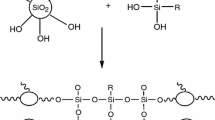Abstract
Organic–inorganic hybrid nanocomposite coatings contain inorganic particles that are dispersed in organic phase in nanometric dimensions. Ceria and zirconia colloidal dispersions are uniformly distributed in the epoxy silica-based hybrid nanocomposite by sol–gel method and coated on 1050 aluminum alloy substrate with spin-coating technique. The hybrid sol is prepared by organic–inorganic precursors formed by hydrolysis and condensation of 3-glycidoxypropyltrimethoxysilane and tetraethylorthosilicate (TEOS) in acidic solution using bisphenol A as networking agent and 1-methylimidazole as initiator in the presence of various ratios of ZrO2 and CeO2 colloidal nanoparticles. Particle size distribution, surface morphology and inorganic components distribution were determined by scanning electron microscopy (SEM) and EDXA techniques. SEM and Si, Zr, Ce mapping micrographs proved the uniform distribution of nanoparticles in the coatings. Transmission electron microscopy indicated that the nanoparticles dimension stay at the nanoscale level. The glass transition temperature (T g) and loss properties (damping) of coatings were evaluated by dynamic mechanical thermal analysis. The corrosion protection of the coatings on the 1050 AA substrate was studied by potentiodynamic measurements. The results indicated that by introducing ceria nanoparticles in 1:1 molar ratio to TEOS in coating composition, corrosion protection was improved. However, the simultaneous presence of two nanoparticles (i.e., ceria and zirconia in 1:1 molar ratio) in the coating compositions increased the corrosion protection efficiency up to 99.8 %. The multiple glass transitions and shifting to higher and wide range of temperatures by adding ceria and zirconia nanoparticles indicated a better network interaction between inorganic nanoparticles and organic molecular chains which also led to better corrosion protection of the coating in this composition.











Similar content being viewed by others
References
Zandi-Zand R, Ershad-langroudi A, Rahimi A (2005) Silica based organic–inorganic hybrid nanocomposite coatings for corrosion protection. Prog Org Coat 53:286–291
Zandi-Zand R, Ershad-Langroudi A, Rahimi A (2005) Synthesis and characterization of nanocomposite hybrid coatings based on 3-glycidoxypropyl-trimethoxysilane and bisphenol A. Iran Polym J 14:371–377
Duan J, Shao S, Jiang L, Li Y, Jing P, Liu B (2011) Nano-attapulgite functionalization by silane modification for preparation of covalently-integrated epoxy/TMPTMA nanocomposites. Iran Polym J 20:855–872
Lou J, Tu S, Fan Z (2010) Polypropylene chain structure regulation by alkoxysilane and ether type external donors in TiCl4/DIBP/MgCl2–AlEt3 Ziegler–Natta catalyst. Iran Polym J 19:927–936
Kang J-S, C-l Yu, Zhang F-A (2009) Effect of silane modified SiO2 particles on poly(MMA-HEMA) soap-free emulsion polymerization. Iran Polym J 18:927–935
Zhao J, Xie X, Zhou X (2011) A nano-hybrid silver colloidal suspension preparation. Iran Polym J 20:845–852
Montemor MF, Trabelsi W, Lamaka SV, Yasakau KA, Zheludkevich ML, Bastos AC, Ferreira MGS (2008) The synergistic combination of bis-silane and CeO2·ZrO2 nanoparticles on the electrochemical behaviour of galvanised steel in NaCl solutions. Electrochim Acta 53:5913–5922
Farhadyar N, Rahimi A, Ershad-Langroudi A (2005) Preparation and characterization of aromatic amine cured epoxy-silica hybrid inorganic–organic coating via in situ sol–gel process. Iran Polym J 14:155–162
Muhamed Ashraf P, Shibli SMA (2007) Reinforcing aluminium with cerium oxide: a new and effective technique to prevent corrosion in marine environments. Electrochem Commun 9:443–448
Montemor MF, Pinto R, Ferreira MGS (2009) Chemical composition and corrosion protection of silane films modified with CeO2 nanoparticles. Electrochim Acta 54:5179–5189
Zandi Zand R, Verbeken K, Adriaens A (2013) Evaluation of the corrosion inhibition performance of silane coatings filled with cerium salt-activated nanoparticles on hot-dip galvanized steel substrates. Int J Electrochem Sci 8:4924–4940
Van Ooij WJ, Zhu DQ, Prasad G, Jayaseelan S, Fu Y, Teredesai N (2000) Silane based chromate replacements for corrosion control, paint adhesion, and rubber bonding. Surf Eng 16:386–396
Cambon JB, Esteban J, Ansart F, Bonino JP, Turq V, Santagneli SH, Santilli CV, Pulcinelli SH (2012) Effect of cerium on structure modifications of a hybrid sol–gel coating, its mechanical properties and anti-corrosion behavior. Mater Res Bull 47:3170–3176
Sakamoto H, Qiu J, Makishima A (2003) The preparation and properties of CeO2–TiO2 film by sol–gel spin-coating process. Sci Tech Adv Mater 4:69–76
Ershad-Langroudi A, Gharazi S, Rahimi A, Ghasemi D (2009) Synthesis and morphological study on the nanocomposite hydrophilic coatings. Appl Sur Sci 255:5746–5754
Kasemann R, Schmidt H (1994) Coating for mechanical and chemical protection based on organic–inorganic sol–gel nanocomposites. New J Chem 18:1117–1123
Davis SR, Brough AR, Atkinson A (2003) Formation of silica/epoxy hybrid network polymers. J Non-Cryst Solids 315:197–205
Khramov AN, Balbyshev VN, Voevodin NN, Donley MS (2003) Nanostructured sol–gel derived conversion coatings based on epoxy-and amino-silanes. Prog Org Coat 47:207–213
Innocenzi P, Brusatin G, Guglielmi M, Bertani R (1999) New synthetic route to (3-glycidoxypropyl)trimethoxysilane-based hybrid organic–inorganic materials. Chem Mater 11:1672–1679
Revie WR, Uhlig HH (2008) Corrosion and corrosion control. Wiley-Interscience, New Jersey
Zou H, Wu S, Shen J (2008) Polymer/silica nanocomposites: preparation, characterization, properties, and applications. Chem Rev 108:3893–3957
Ehsani M, Khonakdar HA, Ghadami A (2013) Assessment of morphological, thermal, and viscoelastic properties of epoxy vinyl ester coating composites: role of glass flake and mixing method. Prog Org Coat 76:238–243
Kannan RY, Salacinski HJ, Odlyha M, Butler PE, Seifalian AM (2006) The degradative resistance of polyhedral oligomeric silsesquioxane nanocore integrated poly urethanes: an in vitro study. Biomaterials 27:1971–1979
Kannan RY, Salacinski HJ, Butler PE, Seifalian AM (2005) Polyhedral oligomeric silsesquioxane nanocomposites: the next generation material for biomedical applications. Acc Chem Res 38:879–884
Ghanbari H, Marashi SM, Rafiei Y, Chaloupka K, Seifalian AM (2011) Biomedical application of polyhedral oligomeric silsesquioxane nanoparticles. Applications of polyhedral oligomeric silsesquioxanes. Adv Silicon Sci 3:363–399
Author information
Authors and Affiliations
Corresponding author
Rights and permissions
About this article
Cite this article
Ershad-Langroudi, A., Rahimi, A. Effect of ceria and zirconia nanoparticles on corrosion protection and viscoelastic behavior of hybrid coatings. Iran Polym J 23, 267–276 (2014). https://doi.org/10.1007/s13726-014-0222-2
Received:
Accepted:
Published:
Issue Date:
DOI: https://doi.org/10.1007/s13726-014-0222-2



